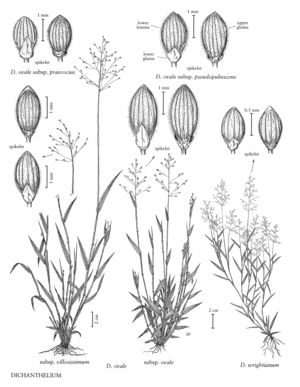Difference between revisions of "Dichanthelium ovale subsp. ovale"
imported>Volume Importer |
imported>Volume Importer |
||
| Line 40: | Line 40: | ||
|publication year= | |publication year= | ||
|special status= | |special status= | ||
| − | |source xml=https:// | + | |source xml=https://bitbucket.org/aafc-mbb/fna-data-curation/src/2e0870ddd59836b60bcf96646a41e87ea5a5943a/coarse_grained_fna_xml/V25/V25_1169.xml |
|subfamily=Poaceae subfam. Panicoideae | |subfamily=Poaceae subfam. Panicoideae | ||
|tribe=Poaceae tribe Paniceae | |tribe=Poaceae tribe Paniceae | ||
Revision as of 21:01, 5 November 2020
Basal blades 3-8 cm, rigid, with long hairs on or near the bases and margins. Culms more than 1 mm thick, stiff; lower internodes pilose; upper internodes short-pilose to nearly glabrous. Cauline sheaths with ascending hairs, hairs to 4 mm, not papillose-based: ligules 1-4 mm; blades 5-12 mm wide, firm, ascending, abaxial surfaces appressed-pubescent, adaxial surfaces nearly glabrous except for the long hairs on or near the scabridulous margins and bases. Spikelets 2.5-3 mm, ellipsoid, sparsely to densely pilose. 2n = 18.
Discussion
Dichanthelium ovale subsp. ovale grows in dry, open, sandy woods, pinelands, and sandhills along the east coast of the United States from New Jersey south¬wards, extending into the coastal plain from eastern Texas to South Carolina, and in Mexico, Honduras, Guatemala, and Nicaragua. It intergrades somewhat with subsp. pseudopubescens. Occasional long-spikelet specimens exhibit morphological characteristics of D. oligosanthes and D. commutatum.
Selected References
None.
